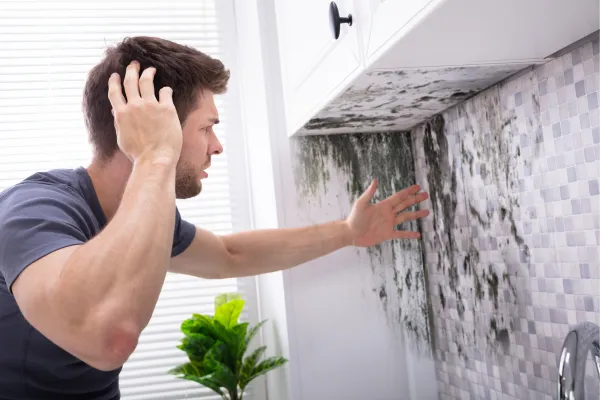Welcome to Our Blog
Insights and tips to keep your living environment safe and healthy.

Mold Evolution & Healthy Air Solutions in Santa Barabara
Welcome to our informative blog on mold testing and building health in Santa Barbara. We'll explore the fascinating science and evolutionary history of mold and its impact on building health. Additionally, we'll discuss how stucco, a popular exterior finish in Santa Barbara, can play a role in mold-related concerns, as well as dive into drywall and mold.

Mold, Nature's Recycler:
In Santa Barbara, mold testing is essential due to the unique climate and older buildings in the area. Mold serves as nature's recycler, breaking down organic materials and returning nutrients to the soil. Let's dive into how mold's role in the ecosystem connects to building health.
How Mold Works:
To understand mold better, we need to delve into its cellular structure and the significance of hyphal networks. These networks facilitate the transfer of moisture and nutrients, a critical aspect of mold's existence. Our Santa Barbara mold testing services explore these intricate details.
The Role of Mycorrhizal Networks:
Santa Barbara's diverse flora and fauna make it vital to understand mycorrhizal networks and their impact on building health. Just as trees in the region rely on these networks to share resources, mold colonies share moisture and nutrients during remediation. It's a fascinating connection worth exploring.

Stucco and Drywall and Rising Damp:
Stucco is a popular exterior finish in Santa Barbara, known for its durability and water-resistant properties. However, improper installation or damage to stucco can make it susceptible to moisture infiltration, including rising damp. Rising damp occurs when groundwater is drawn up into walls through capillary action. We'll discuss how proper installation, moisture barriers, and regular maintenance are essential when using stucco as an exterior finish.
Mold can be a persistent problem in many homes, and it often finds its way into our living spaces through various avenues. One of the common places where mold can flourish is in drywall.
Preventing rising damp in stucco walls involves creating a moisture barrier and ensuring proper drainage. Here are steps to prevent rising damp:
1. Install a Moisture Barrier:
- Apply a waterproof membrane or damp-proof course (DPC) to the foundation walls before applying stucco. This barrier will prevent moisture from being absorbed into the stucco.
- Use materials like bitumen, polyethylene sheets, or specialized waterproofing membranes.
2. Properly Seal Joints and Cracks:
- Ensure that all joints, seams, and cracks in the stucco are properly sealed with a waterproof sealant.
- Pay close attention to areas where the stucco meets the ground or other materials, as these are potential entry points for moisture.
3. Good Drainage:
- Ensure that the ground around the stucco walls slopes away from the building to direct rainwater and moisture away from the foundation.
- Install gutters and downspouts to carry rainwater away from the walls.
- Consider installing French drains or other drainage systems if necessary. We can help you assess the need for landscape improvements to direct water away from your house.
4. Proper Ventilation:
- Adequate ventilation behind the stucco can help prevent moisture buildup. This can be achieved through the use of weep holes or vents in the stucco system.
- Make sure there is a gap between the stucco and the structural wall to allow for air circulation.
5. Select Appropriate Stucco Materials:
- Choose stucco materials that are less porous and more resistant to moisture absorption.
- Some modern stucco systems incorporate moisture-resistant additives to improve their performance.
6. Regular Maintenance:
- Inspect the stucco and the moisture barrier periodically for signs of damage or deterioration.
- Repair any cracks or damaged areas promptly to prevent moisture infiltration.
7. Consult a Professional:
- If you're unsure about how to prevent rising damp or if you suspect a moisture issue, it's a good idea to consult Advanced Clean Air Solutions for an assessment and recommendations tailored to your specific situation.
By following these steps and ensuring that the moisture barrier is properly installed and maintained, you can significantly reduce the risk of rising damp in stucco walls.

Why is Mold a Problem in Drywall?
1. Moisture Intrusion: Mold loves moisture, and drywall can become a breeding ground if it gets wet due to leaks, water damage, or high humidity levels. This moisture intrusion provides an ideal environment for mold to thrive.
2. Porous Composition: Drywall is composed of porous materials like gypsum and paper. These materials readily absorb moisture, creating conditions conducive to mold growth.
3. Organic Food Source: The paper covering on drywall contains organic matter, which can serve as a food source for mold. Mold feeds on organic materials, making drywall an attractive target.
4. Hidden Growth: Mold doesn't always grow visibly on the surface of drywall. It can lurk behind it, within wall cavities, and in areas that are not immediately visible. This hidden growth can be challenging to detect and address.
5. Health Concerns: Mold can release spores and mycotoxins, which can have adverse health effects on individuals exposed to them. These health problems may include respiratory issues, allergies, and other ailments.

Preventing Mold in Drywall
To prevent mold in drywall, it's crucial to take proactive measures:
1. Promptly Address Water Damage: Whenever you encounter water damage in your home, whether it's from a leaky roof or a plumbing issue, address it promptly. Timely repairs can prevent moisture from seeping into your drywall.
2. Maintain Proper Ventilation: Proper ventilation is key to reducing humidity levels in your home. Ensure that bathrooms, kitchens, and other areas prone to moisture have adequate ventilation to minimize the risk of mold growth.
3. Consider Moisture-Resistant Drywall: In areas with a high risk of moisture exposure, such as bathrooms and basements, consider using moisture-resistant drywall. This type of drywall is designed to withstand moisture better than standard drywall.
4. Regular Inspections and Maintenance: Conduct regular inspections (or hire us to do it!) of your home's interior, especially in areas where moisture issues are common. Catching mold growth early can prevent it from becoming a more extensive problem.

Why Choose Advanced Clean air Solutions for Mold Testing in Santa Barbara?
If you suspect mold in your drywall or want to ensure your home is mold-free, Mold Testing Santa Barbara can be your trusted partner. They specialize in professional mold testing and inspection services in the Santa Barbara area.
By choosing Advanced Clean Air Solutions for Mold Testing in Santa Barbara, you'll benefit from:
- Expertise: Our team of experienced professionals understands the local climate and conditions that make mold a prevalent issue in Santa Barbara homes.
- State-of-the-Art Equipment: We use advanced equipment to detect mold even in hidden areas, ensuring a comprehensive assessment.
- Customized Solutions: We provide tailored solutions to address mold issues specific to your home, ensuring effective remediation.
- Peace of Mind: You'll have peace of mind knowing that your home is mold-free and safe for your family.
Conclusion
Mold in drywall and stucco can be a significant concern, but with the right preventive measures and the assistance of experts like Advanced Clean Air Solutions for Mold Testing in Santa Barbara, you can address the issue effectively. Don't let mold compromise the health and safety of your home – take action today to ensure a that your home is a healthy living environment.
Copyright @ 2025 - All rights reserved
Advanced Clean Air Solutions, LLC
351 Paseo Nuevo 2nd Floor #1033
SANTA BARBARA, CA 93101

